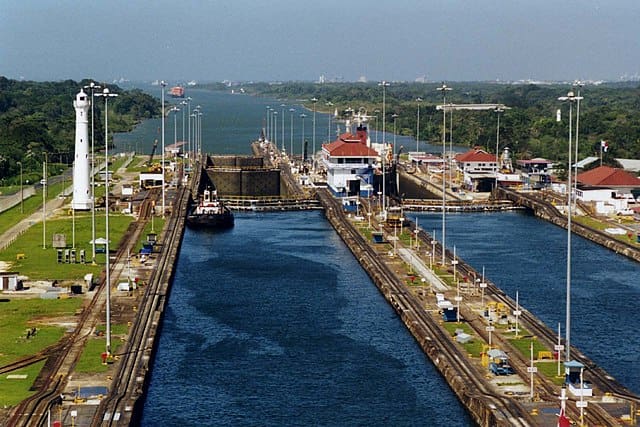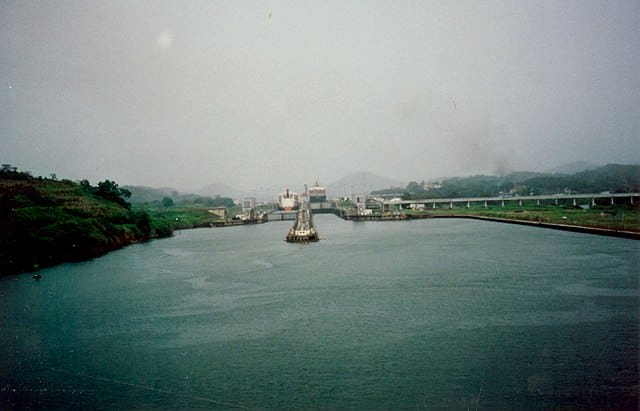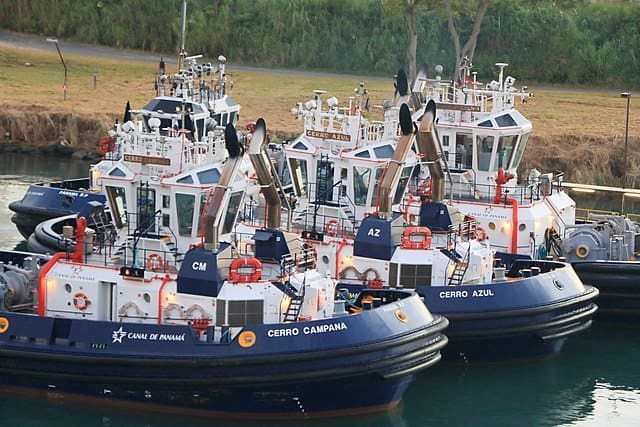15 Amazing Facts About the Panama Canal
A marvel that transcends nature’s limitations may be found in the heart of Central America, amidst lush jungles and tropical terrain. The Panama Canal has grabbed the imagination of adventurers, traders, and visionaries for over a century. It is an engineering marvel, a testimony to human ingenuity, and a gateway between the world’s two mightiest seas.
It’s a location where massive ships are hoisted like elegant giants, and time and distance bow to humanity’s sheer determination. Welcome to a narrative of ambition and creativity, in which the Panama Canal alters geography by uniting the Atlantic and Pacific in an aquatic ballet that changed the path of history.
1. Panama Canal is man-made

Panama Canal Gatun Locks.jpg Stan Shebs, CC BY-SA 3.0, via Wikimedia Commons
The Panama Canal, an astonishing man-made marvel that connects the Atlantic and Pacific Oceans, exemplifies twentieth-century engineering brilliance. Its sophisticated network of locks and canals, which stretches for around 50 miles across the Panama Isthmus, defies nature’s severe hurdles.
This tremendous accomplishment of human ingenuity, conceived as a shortcut between the seas, greatly decreased worldwide shipping distances and prices.
It stands as a tribute to endurance and ambition, having been built through enormous toil and sacrifice, with the United States finishing the project in 1914. The canal’s long influence changed worldwide trade, securing its place as one of modern history’s most awe-inspiring feats.
2. The building of the Panama Canal was faced by many challenges
The grandiose goal of joining two oceans via the Panama Canal was first championed by the French engineer Ferdinand de Lesseps at the turn of the twentieth century. This daring effort, however, ran into significant obstacles. The scorching tropical atmosphere provided a breeding ground for tragedy, with malaria and yellow fever rife among the labour force.
Thousands of employees died as a result of these fatal infections. In the face of these hardships and financial failures, the French initiative eventually failed, leaving a melancholy legacy of sacrifice and tenacity in the face of nature’s unrelenting trials. Although it was a bleak chapter in the canal’s history, it set the path for future success under American guidance.
3. The United States took over the construction in 1904
On May 4, 1904, the United States legally seized ownership of the canal property, inheriting from the French a decimated staff and a massive tangle of buildings, infrastructure, and equipment, most of it in disrepair. The Isthmian Canal Commission (ICC) was founded by the US government to oversee construction; it was granted administration of the Panama Canal Zone, over which the US exercised sovereignty.
President Theodore Roosevelt named John Findley Wallace, formerly chief engineer and eventually general manager of the Illinois Central Railroad, as chief engineer of the Panama Canal Project on May 6, 1904. Overburdened by the disease-ridden country and forced to rely on frequently decrepit French infrastructure and equipment.
4. The Panama Canal uses a system of locks to raise and lower ships

Panama Canal Trip 1994 02.jpg Please credit “Family collection of Infrogmation of New Orleans”., CC BY-SA 4.0, via Wikimedia Commons
Because of the canal’s importance in international trade, many ships are built to the maximum size permitted. For the first century, the canal’s width and length were limited by the Pedro Miguel Locks; its draw by the canal’s minimum depth of 12.6 m (41.2 ft); and its height by the main bridge of the Bridge of the Americas at Balboa.
The Gatun locks were originally intended to be 28.5 m (94 ft) wide. Each lock is 320 meters (1,050 feet) long, with walls ranging in thickness from 15 meters (49 feet) at the bottom to 3 meters (9.8 feet) at the top. At Gatun, the centre wall between the parallel locks is 18 m (59 ft) thick and more than 24 m (79 ft) high. The steel lock gates are 2 m (6.6 ft) thick on average, 19.5 m (64 ft) wide, and 20 m (66 ft) tall.
Read On Top 10 Fascinating Facts about Canals of Utrecht
5. A major expansion of the canal was completed in 2016
The Panama Canal underwent a dramatic enlargement project that culminated in 2016, marking a historic milestone. The “Panama Canal Expansion,” also known as the “New Panamax” project, was introduced to the world through this grandiose undertaking. The construction of new, bigger locks – the Agua Clara Locks on the Atlantic side and the Cocoli Locks on the Pacific side – was key to the project.
These architectural wonders paved the way for a new generation of massive vessels known as “New Panamax” ships, which can carry heavier cargo loads. This enlargement reshaped the canal’s position in global trade, ushering in a new era of increased connectedness and economic potential.
6. The Panama Canal generates significant revenue for Panama

Louis Sola and Paolo Vitelli ( founder of Azimut Yachts) at Panama Canal.jpg Airborne1901, CC BY-SA 4.0, via Wikimedia Commons
The Panama Canal is an important economic lifeline for Panama, delivering significant cash that drives the country’s prosperity. The tolls collected from ships passing through the canal are essential to this cash inflow. These tolls, which are dependent on parameters like vessel size and cargo, are an important source of revenue for the Panamanian government.
They not only support the canal’s operation, maintenance, and modernisation, but they also fund a variety of infrastructure projects and social initiatives, therefore assisting the country’s growth. Panama’s strategic location as a worldwide trade artery assures the country’s long-term status as a significant player in international commerce, as well as its economic stability.
7. The canal provides a shortcut for voyage
The astounding distance shaved off marine routes demonstrates the Panama Canal’s tremendous influence on worldwide shipping efficiency. The canal avoids a daunting 7,872 miles (12,682 kilometres) of travel that would otherwise be required for vessels circumnavigating South America’s hazardous southern point, known as Cape Horn, by offering a shortcut across the Isthmus of Panama.
This massive time and distance reduction not only expedites shipment schedules but also dramatically reduces fuel usage and emissions. The canal’s position as a marine time saver emphasizes its unprecedented importance in advancing global economic and environmental sustainability.
Read On Top 10 Remarquable Facts about Canals of Amsterdam
8. A typical transit through the Panama Canal takes approximately 8-10 hours

Panama Canal Trip 1994 03.jpg Please credit “Family collection of Infrogmation of New Orleans”., CC BY-SA 4.0, via Wikimedia Commons
A normal journey through the Panama Canal is a remarkable feat of efficiency, lasting between 8 and 10 hours. This timeframe, however, can vary according to a number of circumstances, including the size and kind of vessel, as well as the quantity of activity in the canal.
Smaller vessels may finish the journey faster, however, bigger cargo ships or bulk carriers may take longer, particularly during periods of intense congestion. Whatever the factors, the canal’s efficient operations and professionally maintained lock systems guarantee that vessels flow through this astonishing technical wonder with extraordinary speed and precision, supporting smooth worldwide trade.
9. You can watch ships through the Miraflores Locks of the Panama Canal live via a webcam
The Miraflores Locks Webcam allows you to see the Panama Canal from afar. It provides a fascinating insight into the delicate ballet of ships transiting the locks through real-time broadcasting. Observe enormous warships gliding through water-filled tunnels, skilfully managed by professional operators.
This breathtaking vista exemplifies the peaceful union of human brilliance and engineering perfection that allows global trade to flow smoothly via this ancient river. The Miraflores Locks Webcam provides an immersive view into the enthralling world of Panama Canal lock operations, whether you’re a nautical enthusiast, an engineering fanatic, or simply inquisitive about this modern marvel.
10. Destruction of the forests around the Panama Canal was a threat to the canal

Panama Canal Trip 1994 01.jpg Please credit “Family collection of Infrogmation of New Orleans”., CC BY-SA 4.0, via Wikimedia Commons
It was reported in 1978 that “clearing the forest in the watershed may kill the canal.” In 1985, the wooded area had decreased to 30%. Deforestation caused by human population increase, land degradation, erosion, and overhunting were threats to the Panama Canal watershed environment as of 2000. Deforestation promotes erosion, which raises the bottom of the Gatun and Alajuala lakes, reducing their capacity to store water.
Ship activity often pollutes the water; in 1986, a crude oil leak east of the Panama Canal’s Caribbean entry killed vegetation and crustaceans. Invasive organisms can travel quicker, especially with the 2016 extension, on ship hulls or in ballast water. Lake water has accumulated salt over decades.
Read On 10 Best Facts about Canals of Leiden
11. The United States controlled the Panama Canal Zone until 1999
For much of the twentieth century, the United States held authority over the Panama Canal Zone, a strategically crucial expanse of territory. This 10-mile-wide area along the Panama Canal’s path was critical to the canal’s operation and defence. The Torrijos-Carter Treaties, however, were signed in 1977, signalling a historic move toward sovereignty and diplomacy.
These accords paved the way for the ultimate return of the Panama Canal Zone to Panama. The transfer occurred on December 31, 1999, marking a watershed event in Panamanian history when the country reclaimed complete control of its renowned canal, a symbol of national pride and freedom.
12. The Miraflores Visitor Center is a popular tourist attraction in Panama
The Miraflores Visitor Center attracts interested visitors looking for an up-close contact with the Panama Canal’s marvels. This famous tourist attraction provides an immersive experience, with a cutting-edge museum delving into the canal’s rich history, architectural accomplishments, and worldwide significance.
Visitors may see the canal’s complicated operations directly from its strategically placed observation platform, as huge ships traverse the Miraflores Locks with amazing accuracy.
It’s an enthralling vantage point from which to comprehend the immensity of this technical marvel. The centre’s informative exhibits and breathtaking vistas make it a must-see site, giving insight into the Panama Canal’s worldwide significance.
13. The Panama Canal Authority Honors Distinguished Canal Contributors with Prestigious Awards

Panama Canal Tugs.jpg Paul Harrison, CC BY-SA 4.0, via Wikimedia Commons
The Panama Canal Authority has conferred membership in the “Esteemed Order of Bearers of the Master Key of the Panama Canal” and designated a few “Honorary Lead Pilots” to personnel, captains, and dignitaries during the previous century.
One of the most recent was U.S. Federal Maritime Commissioner Louis Sola, who was recognized for his efforts in assisting seamen during the COVID-19 epidemic and having previously transited the canal more than 100 times.
Commodore Ronald Warwick, a former Master of the Cunard Liners Queen Elizabeth 2 and RMS Queen Mary 2, who has traversed the Canal more than 50 times, and Senior Captain Raffaele Minotauro, an Unlimited Oceangoing Shipmaster Senior Grade, of the former Italian governmental navigation company known as the “Italian Line”.
14. The Interoceanic Corridor of the Isthmus of Tehuantepec is a potential competitor of the Panama Canal
Mexico started constructing its own “canal” in 2019, named the Interoceanic Corridor of the Isthmus of Tehuantepec (CIIT), which will largely employ a train to move commerce and passengers from the Pacific to the Atlantic. It is anticipated to begin full operation in December 2023.
The current Corridor is expected to have several advantages over the Panama Canal, including its speed, which will be able to transport cargo from one ocean to the other in about six hours, and its location, which will be closer to the United States than Panama, as well as the establishment of ten industrial parks in the Isthmus with various tax breaks to encourage private investment.
15. The Panama Canal connects large water bodies

Panama Canal PIA03368 lrg.jpg NASA, Public domain, via Wikimedia Commons
The Panama Canal links the Atlantic and Pacific oceans, separating North and South America. The canal spans the Panamanian Isthmus and serves as a marine commercial route.
Canal locks at either end raise ships up to Gatun Lake, an artificial freshwater lake 26 meters (85 ft) above sea level, constructed by damming up the Chagres River, and Lake Alajuela to lessen the amount of excavation work necessary for the canal, and then lower the ships at the other end. A single ship’s passage uses an average of 200,000,000 L (52,000,000 US gal) of fresh water.
Finally, the Panama Canal is a monument to human creativity and tenacity. Its influence on global trade and navigation has changed the worldwide economic landscape. The Panama Canal is a lasting emblem of human achievement, linking continents and encouraging a more linked world, from the daring ambition of its architects to the wonder of contemporary engineering it symbolizes today.
Read On 20 Interesting Facts About Panama
Planning a trip to Paris ? Get ready !
These are Amazon’s best-selling travel products that you may need for coming to Paris.
Bookstore
- The best travel book : Rick Steves – Paris 2023 – Learn more here
- Fodor’s Paris 2024 – Learn more here
Travel Gear
- Venture Pal Lightweight Backpack – Learn more here
- Samsonite Winfield 2 28″ Luggage – Learn more here
- Swig Savvy’s Stainless Steel Insulated Water Bottle – Learn more here
Check Amazon’s best-seller list for the most popular travel accessories. We sometimes read this list just to find out what new travel products people are buying.









